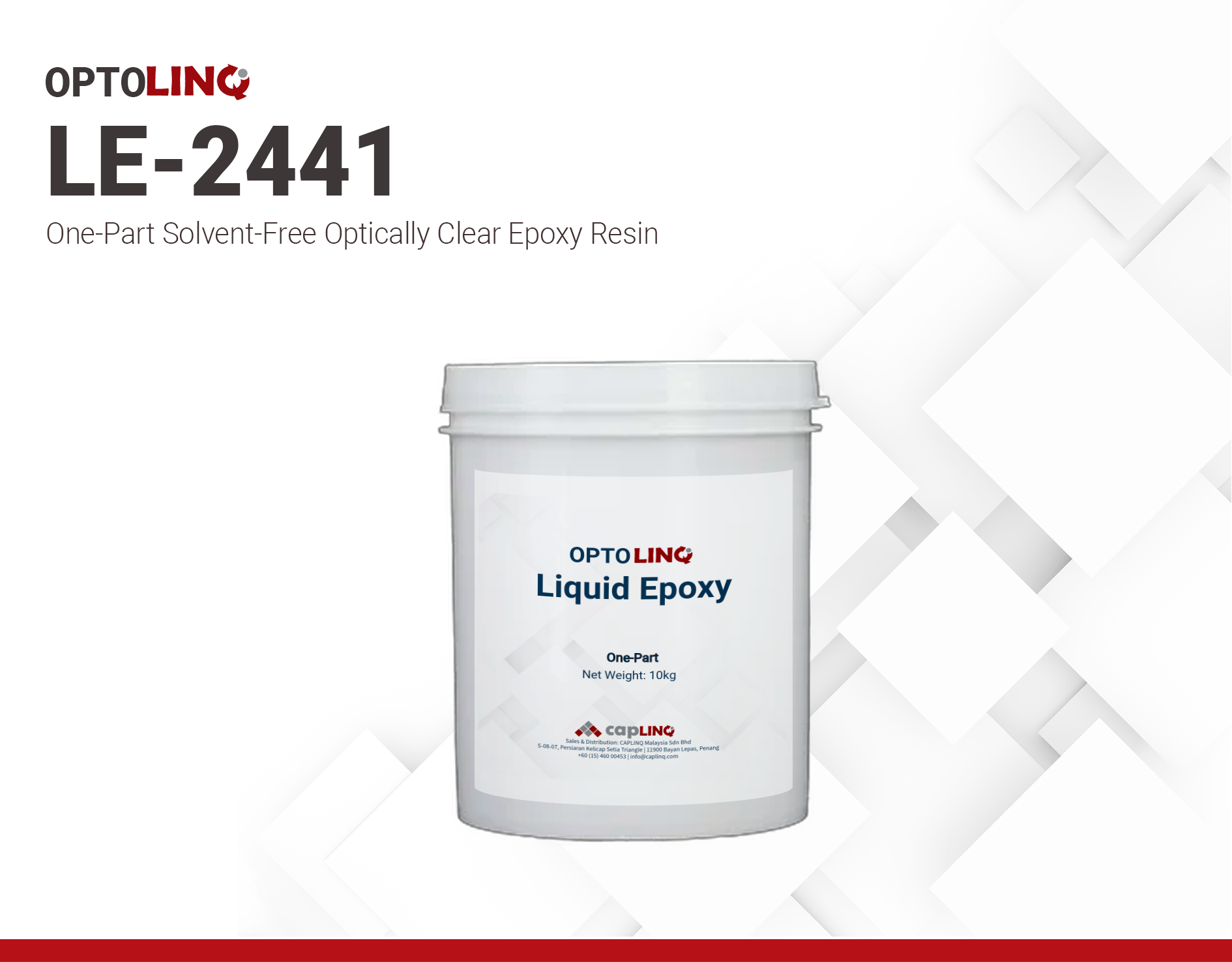LE-2441 | One-Part Optically Clear Epoxy Resin
- High thermal stability (Tg = 157 °C)
- UV curable encapsulation
- High optical transmittance
Product Description
OPTOLINQ™ LE-2441 is a high-performance UV-curable epoxy resin developed for precision optical bonding and encapsulation. Engineered for fast and tack-free curing under 310–365 nm UV light, it offers superior optical clarity, strong adhesion, and robust thermal resistance. Its high refractive index (1.5665), >89% transmittance from 500 to 900 nm, and glass transition temperature of 157 °C make it ideal for LED optics, fiber-optic components, and sensor assemblies. LE-2441 is a solvent-free, single-component formulation with excellent flowability (viscosity: 2,500 ± 500 cP), and no pot life concerns. RoHS compliant and resistant to oxygen inhibition, it ensures stable processing and long-term performance in high-precision applications.
Product Key Features
- Fast UV curing – Cures quickly at 310–365 nm with minimal energy.
- Tack-free surface – Oxygen-insensitive curing avoids surface inhibition.
- High optical clarity – 90% transmittance at 900 nm; ideal for light-guiding applications.
- Optimal refractive index (1.5665), which is ideal for optical components.
- High Tg (157 °C) – Excellent thermal resistance for demanding environments.
- Low CTE (74 ppm/°C) – Ensures dimensional stability in optical assemblies.
- Strong adhesion to Si, Au, die attach materials, and printed circuit board assemblies, and forms airtight seals upon curing.
- Solvent-free, single-component – No mixing required; easy to handle and apply.
- RoHS compliant – Meets EU Directive 2011/65/EU for environmental safety.
Applications
- LED lens encapsulation and UV bonding
- Optical fiber and photonic component assembly
- Sensor and photodiode sealing
- Transparent coatings for display and imaging devices
- Precision bonding in optoelectronic modules
Technical Specifications
| General Properties | |
| Appearance Appearance Appearance at room temperature. | Transparent liquid |
| Refractive index Refractive index The refractive index determines how much the path of light is bent, or refracted, when entering a material. It is calculated by taking into account the velocity of light in vacuum compared to the velocity of light in the material. The refractive index calculation can be affected by the wavelength of light and the temperature of the material. Even though it is usually reported on standard wavelengths it is advised to check the TDS for the precise test parameters. | 1.5665 |
| Specific Gravity Specific Gravity Specific gravity (SG) is the ratio of the density of a substance to the density of a reference substance; equivalently, it is the ratio of the mass of a substance to the mass of a reference substance for the same given volume. For liquids, the reference substance is almost always water (1), while for gases, it is air (1.18) at room temperature. Specific gravity is unitless. | 1.21 |
| Thermal Properties | |
| Degradation temperature Degradation temperature The temperature at which the materials start losing their properties | 377 °C |
| Glass Transition Temperature (Tg) Glass Transition Temperature (Tg) The glass transition temperature for organic adhesives is a temperature region where the polymers change from glassy and brittle to soft and rubbery. Increasing the temperature further continues the softening process as the viscosity drops too. Temperatures between the glass transition temperature and below the decomposition point of the adhesive are the best region for bonding. The glass-transition temperature Tg of a material characterizes the range of temperatures over which this glass transition occurs. | 157 °C |
| Specific Heat Capacity Specific Heat Capacity Specific heat capacity is the amount of heat energy required to raise the temperature of a substance per unit of mass. The specific heat capacity of a material is a physical property. It is also an example of an extensive property since its value is proportional to the size of the system being examined. | 5770 J/(g⋅°C) |
| Weight Loss @ 300°C | 0.63 % |
| Electrical Properties | |
| Visible Light Transmission | 89 % |
| Chemical Properties | |
| Moisture absorption | 0.3 % |
| Physical Properties | |
| Viscosity Viscosity Viscosity is a measurement of a fluid’s resistance to flow. Viscosity is commonly measured in centiPoise (cP). One cP is defined as the viscosity of water and all other viscosities are derived from this base. MPa is another common unit with a 1:1 conversion to cP. A product like honey would have a much higher viscosity -around 10,000 cPs- compared to water. As a result, honey would flow much slower out of a tipped glass than water would. The viscosity of a material can be decreased with an increase in temperature in order to better suit an application | 2500 mPa.s |
Additional Information
LE-2441 Recommended Curing Conditions
| Parameter | Value | Unit |
| Irradiation Wavelength | 310~365 | nm |
| Irradiation Intensity | 100 | mW/cm2 |
| Irradiation Energy Dose | 6000 | mW/cm2 |
Processing Instructions
- OPTOLINQ™ LE-2441 should be stored at 2–13 °C. Before use, keep the sealed container at ambient conditions for 1–2 hours. Do not open the lid until the temperature has equalised to prevent moisture condensation.
- Ensure that all application surfaces are clean, dry, and free of grease, dust, or mold-release agents. Wipe the surfaces with a suitable organic solvent to remove any contaminants that could affect the resin’s adhesion or curing performance.
- Avoid contact with substances that can inhibit curing, such as amines, amine-cured epoxies, or polyurethanes (PU). Direct or indirect exposure to these materials may reduce or completely prevent proper curing of LE-2441. It is recommended to perform compatibility testing prior to production use.
- Wear appropriate protective equipment and minimize direct contact with the human body. Refer to the Safety Data Sheet (SDS) before use.




